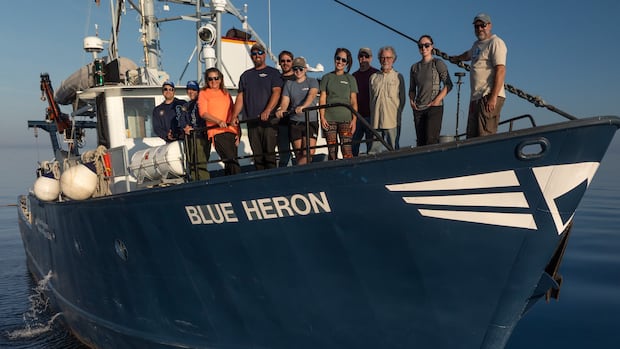Science
Researchers Explore Superior Shoal’s Role in Lake Superior Ecosystem

A research expedition to the Superior Shoal, a submerged mountain in Lake Superior, has provided new insights into its ecological significance. The team from Lakehead University, based in Thunder Bay, Ontario, along with filmmakers, embarked on this nine-day journey to gather data on how this unique underwater structure impacts the lake’s biodiversity.
The Superior Shoal rises nearly 300 metres from the lakebed and is located approximately 70 kilometres from the nearest shoreline. First mapped in 1929, its remote position has contributed to its enigmatic status within the Great Lakes ecosystem. The expedition, supported by a Canadian government grant, utilized the research vessel Blue Heron to reach the shoal, departing from Duluth, Minnesota.
During the expedition, the research team aimed to understand the interplay between physical processes, such as currents and light penetration, and the biological community surrounding the shoal. Michael Rennie, an associate professor at Lakehead University, explained the importance of these interactions. “This is such a unique spot,” he noted. “Much like seamounts in the oceans, these underwater mountains are hotspots of biodiversity and fish productivity.”
The expedition’s findings could have significant implications for the health of the Lake Superior fishery. Rennie highlighted the presence of unique strains of lake trout, including redfin, leans, and siscowet, which thrive in the shoal’s environment. These fish populations have shown resilience, surviving the collapse of the fishery in the 1960s and 1970s due to invasive species and overfishing. “No one ever stocked fish there, and those populations have recovered more or less on their own,” Rennie pointed out.
Filmmakers from Bruce County, Ontario, accompanied the researchers to document the expedition. Yvonne Drebert and Zach Melnich, known for their work with Inspired Planet Productions, took the opportunity to explore the ecological dynamics of the shoal, which they had previously highlighted in their documentary, All Too Clear: Beneath the Surface of the Great Lakes. Melnich expressed excitement about filming in an area rarely explored on camera, noting, “We basically begged Michael to take us.”
To capture the underwater footage, the filmmakers employed a high-tech remotely operated vehicle (ROV) equipped with advanced imaging capabilities. This 27-kilogram robot can descend to depths of approximately 500 metres and features a robust acrylic dome for pressure resistance. Melnich described the ROV’s interactions with the lake trout as intriguing. “The lake trout, especially out at the Superior Shoal, were very friendly with the robot,” he said, highlighting the unique opportunity to observe these fish in their natural habitat.
The footage collected during the expedition will be incorporated into a new series titled Hidden Below: the Freshwater World, slated for release by TVOntario in the coming years. The filmmakers plan to emphasize the importance of underwater structures like the Superior Shoal, advocating for their protection similar to that of marine seamounts.
Drebert reflected on the vastness of the shoal, emphasizing its grandeur beneath the surface. “For folks who are living in Thunder Bay or in Nipigon, looking out at the archipelago, it was really great to visualize what these mountains actually look like,” she remarked.
The research conducted at Superior Shoal not only sheds light on a largely unexplored underwater landscape but also highlights the critical role such ecosystems play in maintaining the health of Lake Superior’s diverse aquatic life. As scientists and filmmakers continue to uncover the mysteries of this underwater mountain, the findings may ultimately inform conservation efforts aimed at preserving the integrity of the Great Lakes environment.
-

 Lifestyle1 month ago
Lifestyle1 month agoWinnipeg Celebrates Culinary Creativity During Le Burger Week 2025
-

 Health2 months ago
Health2 months agoMontreal’s Groupe Marcelle Leads Canadian Cosmetic Industry Growth
-

 Science2 months ago
Science2 months agoMicrosoft Confirms U.S. Law Overrules Canadian Data Sovereignty
-

 Education2 months ago
Education2 months agoRed River College Launches New Programs to Address Industry Needs
-

 Technology2 months ago
Technology2 months agoDragon Ball: Sparking! Zero Launching on Switch and Switch 2 This November
-

 Science2 months ago
Science2 months agoTech Innovator Amandipp Singh Transforms Hiring for Disabled
-

 Technology2 months ago
Technology2 months agoGoogle Pixel 10 Pro Fold Specs Unveiled Ahead of Launch
-

 Science2 months ago
Science2 months agoChina’s Wukong Spacesuit Sets New Standard for AI in Space
-

 Technology2 months ago
Technology2 months agoWorld of Warcraft Players Buzz Over 19-Quest Bee Challenge
-

 Business2 months ago
Business2 months agoDawson City Residents Rally Around Buy Canadian Movement
-

 Technology5 days ago
Technology5 days agoHuawei MatePad 12X Redefines Tablet Experience for Professionals
-

 Science2 months ago
Science2 months agoXi Labs Innovates with New AI Operating System Set for 2025 Launch
-

 Business2 months ago
Business2 months agoNew Estimates Reveal ChatGPT-5 Energy Use Could Soar
-

 Technology3 days ago
Technology3 days agoDiscord Faces Serious Security Breach Affecting Millions
-

 Technology2 months ago
Technology2 months agoInnovative 140W GaN Travel Adapter Combines Power and Convenience
-

 Education2 months ago
Education2 months agoAlberta Teachers’ Strike: Potential Impacts on Students and Families
-

 Technology2 months ago
Technology2 months agoFuture Entertainment Launches DDoD with Gameplay Trailer Showcase
-

 Technology2 months ago
Technology2 months agoGlobal Launch of Ragnarok M: Classic Set for September 3, 2025
-

 Technology2 months ago
Technology2 months agoNew IDR01 Smart Ring Offers Advanced Sports Tracking for $169
-

 Technology2 months ago
Technology2 months agoArsanesia Unveils Smith’s Chronicles with Steam Page and Trailer
-

 Science2 months ago
Science2 months agoNew Precision Approach to Treating Depression Tailors Care to Patients
-

 Technology2 months ago
Technology2 months agoHumanoid Robots Compete in Hilarious Debut Games in Beijing
-

 Business2 months ago
Business2 months agoBNA Brewing to Open New Bowling Alley in Downtown Penticton
-

 Health2 months ago
Health2 months agoGiant Boba and Unique Treats Take Center Stage at Ottawa’s Newest Bubble Tea Shop










